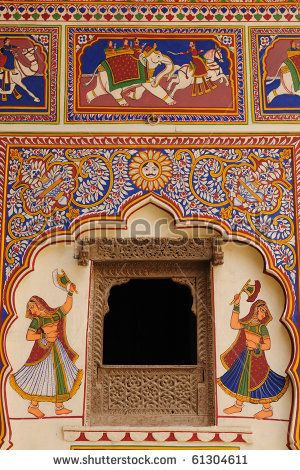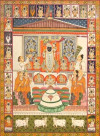India is a land of so many diverse cultures that its art forms seem to be countless in number. This article, for example, is dedicated to Shekhawati paintings - a form of mural painting that adorned the walls of many buildings in Shekhawati, a semi-desert region in north Rajasthan situated entirely in the triangle between Delhi-Bikaner-Jaipur. These paintings were characterised by pictures drawn and colored piecemeal on the dry plaster surface of walls. Subjects ranged from religious and mythological themes to everyday environments and erotica. The paintings of Shekhawati have been an important part of Rajasthan’s - and by extension India’s - cultural heritage.
History of the Art
The first Shekhawati paintings can be traced as far back as the 17th century. The local styles were influenced by the then-Mughal work in Agra and Fatehpur Sikri. The earliest works even included the "Jaipur fresco" work, wherein thick pigments were applied and worked onto a wet plaster surface. The painting technique called "secco" was employed for the interiors. Owing to the support from Rajput rulers and Vaishya merchants in the 18th century, figurative paintings beamed on the walls of many temples and chhatris. Some forts began to contain painted rooms. But the richest era of Shekhawati paintings came in the 19th and 20th centuries - a time when merchants settled elsewhere began to send money home. A lot of construction and painting happened during this time.
Shekhawati Painting Techniques
For the paintings, groups of figures were outlined, then corrected when the artist would colour them in. Although free-hand techniques were applied most of the time, there are signs of dotted stenciled outlines on other buildings. A straight edge was used to construct townscapes. Signs of construction lines created by a tight string covered with ochre or charcoal dust against wet plaster is seen in the notable “Jaipur fresco” work.
Subjects of Shekhawati Painting
Shekhawati painters would paint a variety of subjects that included religion, folk mythology, history, everyday environment, erotica, maps and decorative designs. Religion was the dominating subject; incarnations of Vishnu would be found painted in most places, of which Rama and Krishna were the most popular. Other paintings of gods that were common were those of Shiva, Ganesh, and Durga. When painting folk tales, the painters would portray the entire thing in a single image, for which they chose the most striking event in the story. For history, there are paintings of historical figures, both Indian and British. Erotic pictures of couples making love were generally cheekily hidden amidst murals on external walls. A team of painters would sometimes be commissioned to paint Jaipur or the local town, for example in the palace sheesh mahal at Sikar. Even designs like stylised plants, architectural features, and geometric patterns were common.
Shekhawati Painting Materials and Tools
The paints were mineral or vegetable pigments until the middle of the 19th century. With the coming of the industrial revolution in Germany, chemically synthesised pigments became available for cheap. By the end of the century, a lot many colours and combinations were available.
Prominent Artists
Many chejaras, masons, and kumhars from both Muslim and Hindu communities were attracted to Shekhawati during the building boom. Most of these painters were self-taught, evidently gifted artists. For the finest works, however, teams of professional painters were summoned from Jaipur. These painters from Jaipur and its vicinity would often sign their work.
The Current Scenario of the Art
As merchants began settling more and more in urban spaces in the middle of the 20th century, havelis and chhatris began to be neglected. Buildings collapsed, were whitewashed, or simply broken down - Shekhawati paintings began to decline. Some effort has been put into preservation, however; for example by groups such as the Morarka family of Nawalgarh. In the Jawahar Kala Kendra, Jaipur, and National Crafts Museum, Delhi, commissioned Shekhawati paintings are present. A stamp honouring these paintings was issued in 2012.
Picture Source: Pinterest


